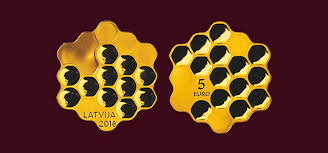Latvia’s central bank is abuzz – and for once it has nothing to do with the ongoing investigation into allegations of corruption against its governor.
On Tuesday, 22 May, Latvijas Banka is issuing a collector coin dubbed the “Honey Coin” which won the first prize in the competition for the best design of an innovative collector coin.
The competition was announced in January 2017 to search for ideas to create an innovative coin in terms of its motif, design or technical solution. Overall, 42 works were submitted and were evaluated by the Coin Design Commission of Latvijas Banka. The first prize was awarded to designer Artūrs Analts’ work “Honey”.
We’ll let the central bank explain the rest in its own inimitable fashion.
“Honey has a special role in Latvia. Together with the diligent honey bees it is widely present in our folk songs; it is an important food, traditional medicine and cosmetics product. Citizens, who are as busy as bees in their day-to-day lives, fill their country like bees fill a hive. Therefore, the “Honey Coin” is a symbol of diligence and sweetness of work. The bees also have a significant role to play in maintaining the biological diversity, and their presence is an indicator of nature’s healthiness.” drones the bank.
Furthermore “Bees have been working hard on the Earth for millions of years,” the bank explains, adding that “The rather selfish friendship of humans with bees emerged as a result of continuous fight for livelihood. Initially they used the generous gifts arising from efforts of bees in a cautious manner in natural surroundings. It was the honey harvested from the nests of forest bees that our ancestors tasted first. The oldest man-made beehives of the 10th century BC have been found in the Middle East in the territory of the present-day Israel. The scientific foundations of beekeeping were laid in German states only at the end of the 18th century. In the 19th century, beekeeping specialists in various countries across the globe contributed to the creation and improvement of the modern hives with removable frames (or honeycombs) and with bee-entrances.”
Want to know more? Of course.
“Honey was used to cure wounds and illnesses in ancient Egypt. Egyptian pharaohs also made use of honey during religious rituals. In ancient Greece, mathematician Pythagoras (~580–500 BC) and philosopher Democritus (~460–370 BC) believed that eating honey was a precondition for a long life. Meanwhile, Aristotle (384–322 BC), the founding father of natural sciences, recommended honey as a means for curing eye diseases, while Hippocrates, the founder of medicine, invited people to use honey both on its own and together with water or wine. He believed that honey was nourishing, that it made one’s face look better and that it had medicinal properties. The ancient Greeks appreciated honey to the extent that they featured a honey bee on their coins. Meanwhile, honey served as a valid form of currency for the Romans since many people paid their taxes in honey.”
“None of the bees living in a colony consisting of 30–80 thousand bees ever sleeps, each bee collects food for the colony and construction materials for the hive and breeds new generations of bees. The collected nectar and pollen are turned into honey and bee bread. Bees, which are up to one and a half centimetres long winged insects weighing about one tenth of a gram, produce a fantastic quantity of honey for people every year,” quoth the central bank before signing off with a poem that might just as easily apply to any high-profile public official as the lowliest nectar thief.
Lazybones, go to a bee
To learn its virtue.
It has neither masters nor elders
In its sweet daily job.
The “Honey Coin” featuring honeycomb cells is struck in silver and plated with gold. Honeycomb cells form a rough outline of the geographic contour of Latvia and the Gulf of Riga. Various types of frosting are applied to achieve this effect. The shape of the coin is unique: several coins can be placed side-by-side like pieces of a puzzle to build-up an even larger honeycomb the same way as bees do it in their hive. The coin has been struck by UAB Lietuvos monetų kalykla (Lithuania).
The maximum mintage of the coin is limited to 3 000. The price of the coin at Latvijas Banka Cashier’s Offices and via e-monetas.lv is 53.00 euros each. It’s worth 5 euros if you want to spend it rather than pore over it in a display case between doses of royal jelly.
The “Honey Coin” featuring honeycomb cells is quite an unusual silver collector coin plated with gold. The face value of the coin is 5 euro, and its weight is 16.50 g. The coin has been struck by UAB Lietuvos monetų kalykla (Lithuania).
The new coin will be available for purchase starting from 8.30 a.m. on 22 May via the website www.e-monetas.lv and at the Cashier’s Offices of Latvijas Banka in Riga and Liepaja.
The maximum mintage is limited to 3000.
The price of the coin is EUR 53.00.
Limit of the number of coins per purchase at the Cashier’s Office and online at e-monetas.lv is 2 coins.









